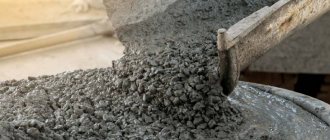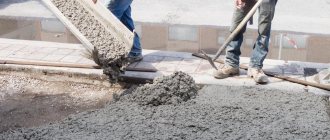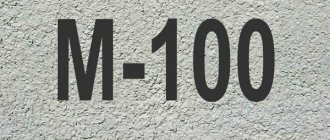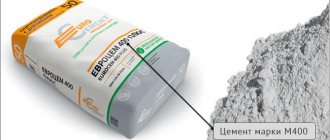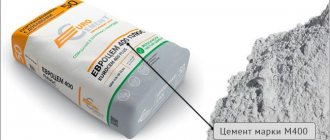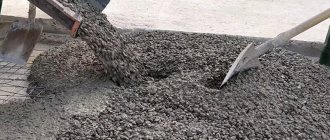- 1 Scope of application
- 2 Technical specifications
- 3 Composition
- 4 Cost
- 5 Mixing 5.1 Proportions of “ingredients” of the cement brand
The M100 concrete grade is popular in repair work not only because of its wide range of applications, but also because of its excellent characteristics. To lay M100 concrete, you do not need to make a lot of effort; any shape can be filled with concrete. Suitable for small construction work without the use of special tools and devices.
Scope of application
Concrete grade M100 has low resistance to loads, so it is used only in work where they are insignificant. For example, in preparatory work before pouring the foundation, it acts as a concrete pad, which creates a barrier for cement laitance, protecting the lower layer of reinforcement from corrosion.
You can’t do without it on roads either: pour it in a thin layer no more than 10 cm thick on a bed of sand, wait for it to harden and install the reinforcement. This is how sidewalks, pedestrian paths, curbs, fences, and small pillars are made. It is also necessary for equipping different types of sites: parking lots, stops. This type of concrete has found its application even in agriculture: in places where concreting needs to be done directly on the ground (cellar, barn) for laying a “rough” floor.
Class B7.5 is called “skinny” and is used in the manufacture of reinforced concrete blocks, which in the future will not be subject to strong pressure.
Return to contents
Where is M100 concrete used?
The relatively small load-bearing capacity of this grade of concrete has determined a relatively limited scope of application. In particular, heavy concrete m100 GOST 26633-2015 is used in the following construction and concrete works:
- Preparatory concrete work.
- Repair of defects in concrete structures and structures.
- Construction of concrete floors in interior spaces.
- Arrangement of blind areas around private and office buildings.
- Construction of pedestrian paths in private and country houses.
- Installation of curbs and other road preparation work.
It should also be noted that in Soviet times, 7.5 m100 concrete was widely used as the main material for the construction of walls of one-story residential buildings, which are successfully used to this day, without any questions about strength and durability.
Therefore, if a private developer is faced with the task of erecting a one-story house building up to 3 meters high, the technical characteristics of M100 concrete will fully ensure the strength and durability of the structure, all other things being equal.
Specifications
- density - 2370-2400 kg/m3;
- volumetric mass = 1840 kg;
- strength - B7.5 (98 kg/cm2);
- water resistance - W2-W4;
- mobility - from P2 to P4;
- hardness - Zh2-Zh4;
- frost resistance – F50-F100.
Please note that the class of water resistance and frost resistance may vary depending on the fillers. For example, crushed limestone has lower strength values than crushed granite. Depending on the aggregates, three types of M100 concrete are distinguished by specific gravity:
- lightweight - 500-1800 kg, contains porous aggregates (expanded clay, shell rock, tuff) or foaming agents;
- heavy;
- 1800-2300 kg, filled with gravel or crushed stone;
- especially heavy - up to 3000 kg, contains metal additives. The material is manufactured in accordance with GOST 7473-94.
Return to contents
Concrete production
Concrete mortar is prepared from available ingredients; this mixture will be indispensable when performing various construction stages. Manufacturing technology must be followed using the highest quality components. Concrete grade M 100 contains the following filler options:
- gravel;
- crushed limestone with a fraction from 5 to 20 mm;
- granite fillers;
- There is no need to add stabilizers and modifiers.
Compound
It is based on simple components such as cement, sand and crushed stone. Depending on the class of cement, the proportions in concrete may be different. So, for example, when using M500 cement, more fillers will be required than when using M400 cement.
The ratio of M400 cement, sand and crushed stone is 1: 4.6: 7.0. For cement M500: 1: 5.8: 8.1.
Approximate composition of M100 concrete per 1 cubic meter:
- Water - 0.21 m3.
- Sand - 0.58 m3.
- Crushed stone—0.8 m3.
- Cement M400 - 250 kg.
Return to contents
Production technology
The production of mortar for any brand of concrete is identical. It is only important to comply with all technological conditions. Then you will get a high-quality solution of the required consistency, which will ensure the durability and strength of the structure being poured.
Even a small error in the production process can lead to a decrease in the quality properties of concrete.
The process of producing concrete for private and industrial construction is almost the same and includes a strict procedure:
- Preparation of the main components of the solution. Includes washing, cleaning and sifting of dry fillers - sand and crushed stone. The water is filtered to prevent the presence of various suspensions and particles in it. Portland cement is suitable only for recently produced cement, which has not yet had time to compact and form lumps.
- Mixing components. First, the dry fillers and Portland cement are mixed. Lastly, add water and mix until smooth.
In private construction, mixing can be done manually or in a small-volume concrete mixer. Concrete plants use concrete mixers (planetary, twin-roll, disc), which allow mixing huge volumes of mortar.
Uniform distribution of components in the solution guarantees the strength and durability of the structures being poured.
- Compliance with technological production conditions. Kneading should be done at a temperature of 20 ℃ and a humidity of 40-60%. It is important to maintain these indicators throughout the entire time – from mixing the components to delivering the concrete to the construction site. Otherwise, the mixture will separate and it will lose its properties.
The cement is mixed until smooth. For private construction, the mixing time depends on the fraction of the components. In factory conditions, this is solved computerized - depending on the application and the scope of application of the concrete.
Price
The price per cubic meter of M100 concrete may vary. It is influenced by the properties of the filler, the brand of cement, the additives used, the season of purchase and the cost of delivery. In Moscow, the estimated price will be from 2,650 to 3,230 rubles per 1 cubic meter.
Please note that M100 concrete is often sold with transportation by the seller. Therefore, for transportation costs you will pay from 400 to 700 rubles per 1 cubic meter. Unloading products may take some time, so for forced downtime of the seller’s transport you will have to pay from 1000 to 1500 rubles per 1 hour.
Return to contents
Concrete 100 – area of use
The operational properties and low technical characteristics of the M100 concrete composition allow it to be used to solve a limited range of problems.
The building material is used for the following purposes:
- carrying out preparatory activities for pouring reliable foundations;
- formation of the underlying base for road surfaces and sidewalks;
- ensuring the immobility of road curbs;
- creating a stable platform for laying reinforced concrete blocks;
- pouring rough foundations directly onto the ground in non-residential premises;
- concreting floors in basements and cellars.
The specific application of the material involves pouring it in a thin layer directly onto the surface of the soil or compacted sand cushion. If necessary, the solution can be strengthened with steel reinforcement, which increases its strength. If M100 concrete grade is ordered from the manufacturer to perform certain work, the characteristics of the solution are indicated in the accompanying documents. Pay attention to certificates confirming the quality of this building material.
Kneading
To obtain high-quality concrete, M400 and M500 cement is suitable; other brands should not be used due to the low strength of the material.
Return to contents
Proportions of the “ingredients” of the cement brand
Using M400 cement, you will need 1 part cement, 4.6 parts sand and 7 parts aggregate. For M500 the ratio is different: 1.0: 5.8: 8.1. There are no standards regarding water; there should be enough of it so that the consistency of the concrete mixture is not too liquid, but plastic. Also, the amount of water depends on weather conditions during installation. If the volume of concrete mixture is large, a concrete mixer is used for mixing; if it is needed for small construction work, you can mix it manually.
Here is a general option for obtaining 1 cubic meter of concrete solution. We will need any metal container of sufficient volume, a bucket, a shovel and a hoe. First, let's fill in all the dry ingredients: 200 kg of cement; 750 kg of sand, 1200 kg of crushed stone, and mix them thoroughly with a hoe. As already mentioned, the amount of water is individual for each solution, in our case it is 180 liters. First add 8 liters and mix vigorously so that there are no lumps. The solution should be pulled by a shovel. Then pour in the rest of the water.
There is another mixing method, when water is first poured in, mixed with cement, then with sand. At the end you need to fill in the crushed stone and mix. The main thing is that the concrete mixture does not delaminate.
Return to contents
Advantages and disadvantages
Advantages of M100 concrete:
- Low cost and availability of materials, which will reduce construction costs.
- Reliability, that is, when exposed to various adverse natural phenomena, the structure will maintain its integrity.
- Durability. Thanks to the existing technical and strength indicators, M100 concrete is capable of not losing its properties for a long time.
- Safety. The components included in the concrete solution are absolutely safe and environmentally friendly; they are not capable of having a detrimental effect on human health.
- Availability of excellent technical indicators.
- Moisture resistance. Concrete does not collapse when exposed to moisture and protects reinforcing bars from corrosion.
- Although the area where this brand of concrete is used is limited, it is still wide. It is used both in the construction of roads and in the construction of houses.
- Frost resistance. The solution can withstand from 50 to 100 cycles of freezing and thawing, so it can be used in any climate zone.
The main advantages of this concrete are its resistance to moisture and interaction with the soil. This feature allows you to carry out work on arranging paths in parks and gardens, installing fence posts, as well as other work where there is contact with the ground.
Flaws:
The main disadvantage of M100 concrete is its low strength after hardening. After preparing the base, steel reinforcement is laid on the surface of the M100 concrete screed. Then they begin to work with concrete of the higher grade. The disadvantages include:
- Possibility of cracks. Because of this, the integrity of the structure is compromised and performance is reduced.
- M100 concrete cannot be used for load-bearing structures due to its low strength.
To increase strength indicators and reduce the likelihood of defects, various bitumen-based emulsions are added to the mixture.
The influence of concrete weight on its characteristics
It is important to understand that the weight of a concrete mixture is only indirectly related to its strength - the ability to withstand existing loads. The mass of a material and its density are interrelated characteristics: the higher the density, the more concrete weighs. A fully set dense solution actually has higher strength, water resistance, and frost resistance. We should not forget that other factors significantly influence strength: cement quality, water-cement ratio, additives used, mixing mode, conditions for strength development.
Return to list


